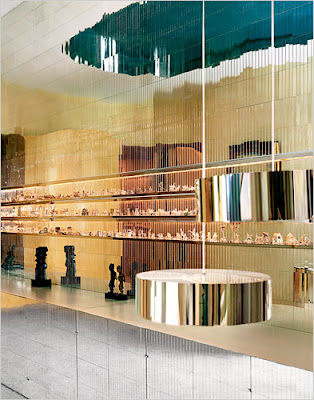“Paul worked because he needed to. He needed to create.”

"According to the owners, there are more than 1,000 light bulbs in the apartment.
Rudolph used those bulbs to create borders —
almost like dotted lines of light — around the living areas."


For Rudolph, who was known for molding concrete into shapes so intricate that they sometimes resembled M. C. Escher drawings, this apartment on a single floor of a prewar building must have felt confining. Rudolph’s free-standing buildings can have as many steps as doors or windows; his Art and Architecture Building at Yale University, though only seven stories high, is said to have 37 levels. But in the apartment, Rudolph found ways to work in three dimensions, installing built-in furniture that sweeps around the rooms, creating peninsulas and islands that seem truly topographic. In the husband’s office, a wavy, multilevel platform turns a rectangular space into a kind of cove while functioning as a wraparound library ladder.
Unlike many of his contemporaries — Modernist architects who preferred their walls white and unadorned — Rudolph threw himself into creating novel surface treatments, many involving tricks of scale and the subversion of expectations. In the living room, Rudolph had mirrors cut into half-inch-wide vertical strips, then applied them like tiles to the curving walls. And instead of hiding the owners’ collection of silver miniatures in a cupboard, he arranged the pieces in front of the mirrors and lit them with hundreds of concealed incandescent bulbs. (And he did so without access to the L.E.D. strips that make such jobs a cinch today.) The result is a tableau in which the tiny collectibles dazzle like diamonds in a Tiffany & Company window.
read full article
from NY TIMES here...
"shining moment"
Paul Rudolph.
------------------

